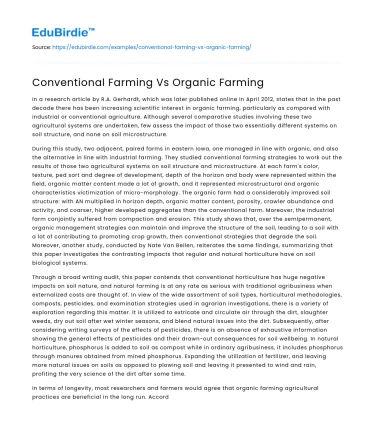In a research article by R.A. Gerhardt, which was later published online in April 2012, states that in the past decade there has been increasing scientific interest in organic farming, particularly as compared with industrial or conventional agriculture. Although several comparative studies involving these two agricultural systems are undertaken, few assess the impact of those two essentially different systems on soil structure, and none on soil microstructure.
During this study, two adjacent, paired farms in eastern Iowa, one managed in line with organic, and also the alternative in line with industrial farming. They studied conventional farming strategies to work out the results of those two agricultural systems on soil structure and microstructure. At each farm's color, texture, ped sort and degree of development, depth of the horizon and body were represented within the field, organic matter content made a lot of growth, and it represented microstructural and organic characteristics victimization of micro-morphology. The organic farm had a considerably improved soil structure: with AN multiplied in horizon depth, organic matter content, porosity, crawler abundance and activity, and coarser, higher developed aggregates than the conventional farm. Moreover, the industrial farm conjointly suffered from compaction and erosion. This study shows that, over the semipermanent, organic management strategies can maintain and improve the structure of the soil, leading to a soil with a lot of contributing to promoting crop growth, then conventional strategies that degrade the soil. Moreover, another study, conducted by Nate Van Beilen, reiterates the same findings, summarizing that this paper investigates the contrasting impacts that regular and natural horticulture have on soil biological systems.
Save your time!
We can take care of your essay
- Proper editing and formatting
- Free revision, title page, and bibliography
- Flexible prices and money-back guarantee
Through a broad writing audit, this paper contends that conventional horticulture has huge negative impacts on soil nature, and natural farming is at any rate as serious with traditional agribusiness when externalized costs are thought of. In view of the wide assortment of soil types, horticultural methodologies, composts, pesticides, and examination strategies used in agrarian investigations, there is a variety of exploration regarding this matter. It is utilized to extricate and circulate air through the dirt, slaughter weeds, dry out soil after wet winter seasons, and blend natural issues into the dirt. Subsequently, after considering writing surveys of the effects of pesticides, there is an absence of exhaustive information showing the general effects of pesticides and their drawn-out consequences for soil wellbeing. In natural horticulture, phosphorus is added to soil as compost while in ordinary agribusiness, it includes phosphorus through manures obtained from mined phosphorus. Expanding the utilization of fertilizer, and leaving more natural issues on soils as opposed to plowing soil and leaving it presented to wind and rain, profiting the very science of the dirt after some time.
In terms of longevity, most researchers and farmers would agree that organic farming agricultural practices are beneficial in the long run. According to Timothy A. and his colleagues, “In an investigation of 18 years of harvest yield and homestead, executives derived from a previous study at the University of Minnesota showed that the natural yield revolution was reliably more gainful and conveyed less danger of low returns than regular corn and soybean creation when natural prime expenses were cut considerably. The cost of buying substance herbicides in the 2-yr customary pivot surpassed the expense of controlling weeds precisely in the natural framework, prompting higher creation costs in the ordinary revolution, despite the fact that natural creation included more field activities, Delbridge includes” (paragraph 5-7).
To conclude, organic farming is a much better type of farming practice than conventional farming, and it can be proven through many research papers and articles that contain thorough tests and experiments by experts in the field. An excellent summary example of this is that conventional produce contains a mixture of harmful chemicals that can negatively affect people, especially children, and also the devastating effects of production on large sections of land barren and polluted. Overall, the important aspect of this essay is that conventional farming produces more and its produce are way cheaper compared to the commodity and production process in organic farming However, organic farming is overall better in terms of health and safety benefits and the survival of the future environment. Therefore, organic farming and practices should be reinforced and inducted back into societies as not only is it beneficial to the human health and environment, but also the future generation.






 Stuck on your essay?
Stuck on your essay?

